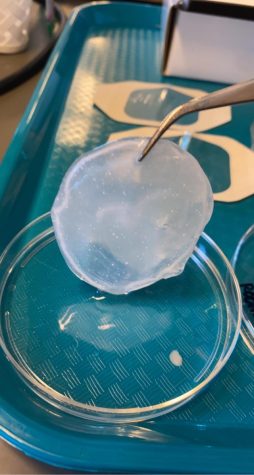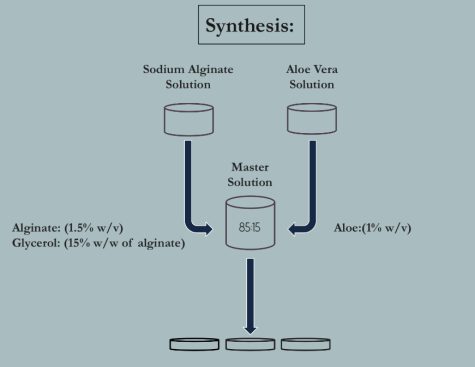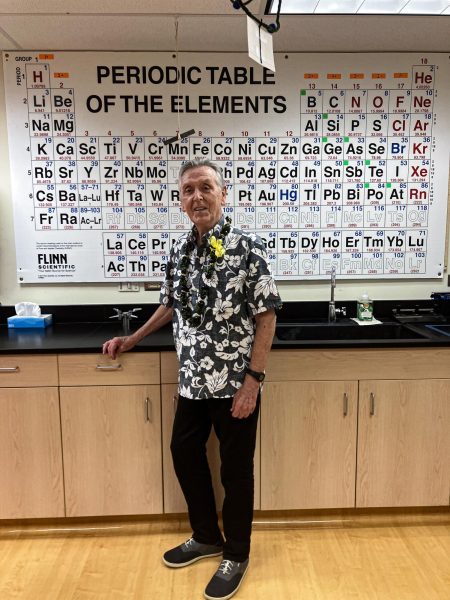Independent Research Feature: Engineering a Biodegradable Hydrogel with an Infection Indicator for Clinical Wounds

Traditional wound dressings have been standard medical gear for years, typically consisting of gauze to protect wounds from bacterial infection (Dhivya, 2015). Yet recent study has begun to circle into improving the standard wound dressing, moving from textiles and plasters to naturally derived forms of synthetic material (Pereira, 2013). The main goal of these studies has remained the same: transition from textile wound dressings to polymeric bandages. This new form of biotechnology has evolved through experimentation to produce wound dressings that stimulate cell growth by increasing collagen production, maintaining a moist environment, and remaining non-adhesive to wounds and antibiotics. Variations of bio-polymers/polymeric materials have been successfully synthesized to improve factors of a typical gauze dressing such as sturdiness, eco-friendliness, cost-efficacy and accessibility, removing exudates or bodily fluids from infection, and the prevention of infection (Ghomi, 2019). There are many types of dressings such as Hydrogels,
Despite bandages and dressings protecting wounds, infection is a complication that every wound is susceptible to. Infection forms when germs enter the wound and multiply to when the body has a reaction to the outbreak. This common issue resulted in my goal to incorporate a color changing mechanism, using pH, as an infection indicator.
Similar to prior studies, the main goal was to work with former knowledge of polymeric dressings and synthesize a wound dressing that can resist bacteria and indicate infection by changing color.
Potential Hydrogen, abbreviated as pH, is the measure of hydrogen ions present, which is shown by the substance’s change of color (Escobar, 2020). Knowing the general pH for healthy skin lied between 4.5 and 6,

I chose the non-toxic chemical indicator, Bromothymol Blue, as my indicator (NCBI). Bromothymol Blue’s pH spectrumhas a range between 6.0 and 7.6, which is within the range of an infection. Therefore, I assumed the lighter the blue becomes, the more basic and infected the wound is. This pH indicator has also been used in high school labs and is often experimented on living organisms like fish to test for water acidity.
During synthesis a basic aloe vera/Alginate Hydrogel was made by combining sodium alginate, ultrapure water, aloe vera, glycerol, and calcium-chloride. Two solutions were prepared to form the Hydrogel mixture. Sodium Alginate (1.5% w/v), Glycerol (15% w/mass of alginate), and Ultra Pure Water (v/v) were combined using a magnetic stirrer to create the first solution. Simultaneously, the aloe vera solution is created by the aloe vera (1% w/v) and Ultra Pure Water (v/v), combined by magnetic mixing. The two solutions are combined together at a ratio of 85:15 and incubated at 25°C at a controlled humidity of 50% ±5 (Pereira, 2013). The incubation period allowed the gels to turn from a liquid/gel state to a semi-solid state, allowing for the crosslinking process to begin. Cross Linking, using 5% calcium chloride, allows for the polymers to bond on a molecular level, using ionic bonding. Cross Linking transitions the semi-liquid hydrogel into a solid state, promoting sturdiness within the dressing. After the crosslinking process, the gels are doused in a water bath and aired out at room temperature.

Through much trial and error, I was able to successfully synthesize a hydrogel with an infection indicator. Troubleshooting my experimental issues led me to changing my indicator from a natural extract indicator to the Bromothymol Blue, working out kinks in humidity and overdrying the hydrogels. Future goals in my research include adding a semi-permeable membrane, using a natural indicator (anthocyanin) and performing multiple tests for sterility and antibacterial resistance.
The main purpose of crafting this hyogel was to be able to detect, alert, and protect the user when they have an infection. Many people are unaware of wound infections and often downplay the severity of one,barring the chances of necrotizing infections. Professional help is often not considered until infections become severe, which is why receiving help early is beneficial in order to prevent painful agonizing wound infections.
References
Dhivya, S., Padma, V. V., & Santhini, E. (2015). Wound dressings – a review. BioMedicine, 5(4), 22. https://doi.org/10.7603/s40681-015-0022-9
Escobar, K., & Blosse, S. (2020, August 21). pH Indicators (K. Nakajima, Comp.). Libre Texts. https://chem.libretexts.org/Bookshelves/Physical_and_Theoretical_Chemistry_Textbook_Maps/Supplemental_Modules_(Physical_and_Theoretical_Chemistry)/Acids_and_Bases/Acid_and_Base_Indicators/PH_Indicators
Kuo, S. H., Shen, C. J., Shen, C. F., & Cheng, C. M. (2020). Role of pH Value in Clinically Relevant Diagnosis. Diagnostics (Basel, Switzerland), 10(2), 107. https://doi.org/10.3390/diagnostics10020107
Pereira, R., Mendes, A., & Bártolo, P. (2013). Alginate/Aloe vera hydrogel films for biomedical applications. Centre for Rapid and Sustainable Product Development, Polytechnic Institute of Leiria, Centro Empresarial da Marinha Grande-Rua de Portugal, 2430-028 Marinha Grande, Portugal. http://www.sciencedirect.com
Rezvani Ghomi, E., Khalili, S., Nouri Khorasani, AS. Esmaeely Neisiany, R., Ramakrishna, S. (2019), Wound dressings: Current advances and future directions. J. Appl. Polym. Sci., 136, 47738







arisa • May 18, 2022 at 11:24 am
YAS CLARA